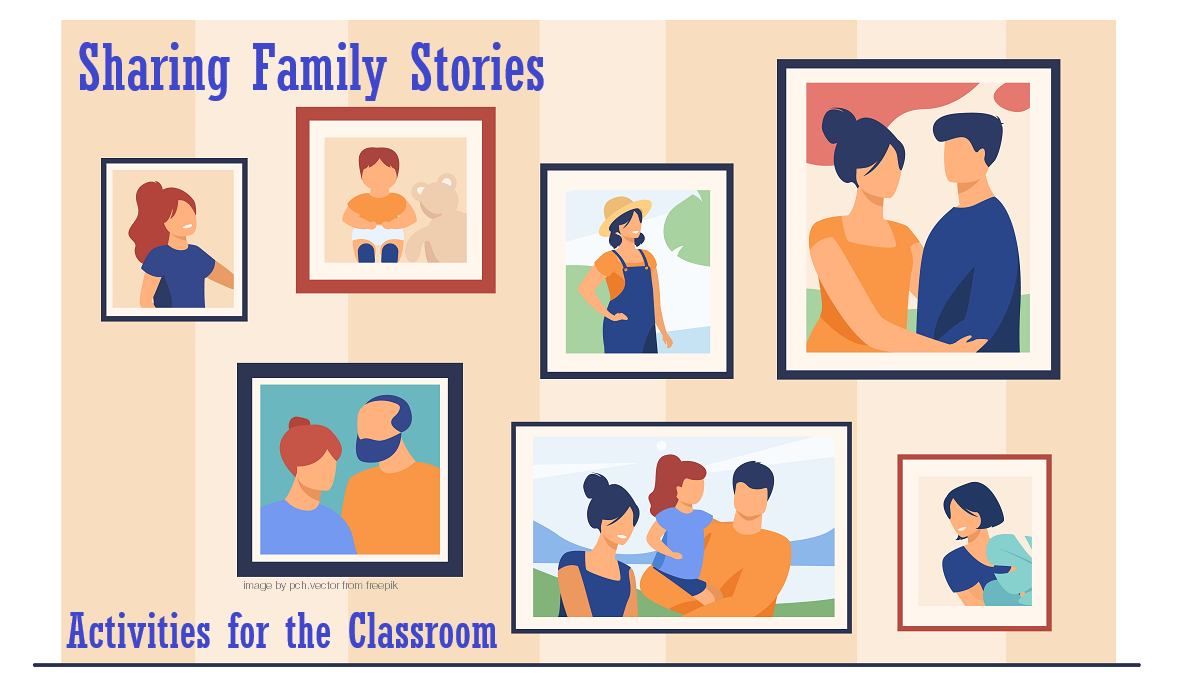
Growing up, flipping through family photo albums, and asking questions about each picture was part of my childhood. As I got older, I could retell the stories to visiting relatives and friends as if I were part of each event including details such as what each person said, why they were laughing or crying, even the smell of the food, flowers, or person (as applicable, of course!).
Sharing family stories can become a tradition, rich in memories both old and new. As our world seems to gravitate towards more web and social media use for sharing stories, there is still value in sitting together as a family and recounting cherished occasions. We all benefit from the interchange of special milestones, exciting adventures, and life-changing experiences. What are some ways to incorporate sharing family stories in the classroom?
Oral Storytelling
Oral storytelling encourages the storyteller to use voice, facial expressions, and gestures to recount an experience. Introduce students to oral storytelling through video or your own personal story. Before sharing a story with your class, make a video of you telling the story. Are you making sure to change tone and expressions when needed? How do gestures emphasize or take away from the story? When students see the amazing job you do, they will think of ways to make their own stories come to life!
Show and Tell
A timeless favorite is ‘Show and Tell.’ Have students bring in a special picture or memento that will be the basis of their story. For example, a student brings in a baby blanket and shares that this was the first blanket given to her as a baby in the hospital. She will then go on to recount what happened on the day she was born. The benefit of this activity is that, depending on the item, students will need to talk with someone in the family to get all the relevant details pertaining to the item which is a bridge to their own families sharing stories!
Use the document camera in your classroom for smaller objects so that details can easily be seen by all in the class. For shyer students, using the doc camera can also serve to move the focus from them to the item, helping to make them more comfortable as they share.
Digital Photo Album
Incorporate the fun and interactivity of technology by having students create digital photo albums using slide presentation applications or software. Slide presentation tools and features have come a long way from the basic ‘slide show’ of text. Creators can add text, tables, and transitions, as well as animations, audio, links, and videos. Do remind them that too many ‘bells and whistles’ can be distracting and to use slide features as ‘accents’ to the album. With this project, students will boost essential 21st century skills such as creativity and communication.
Choose a week for students to sign up and present their digital albums. If you have an interactive display, students can choose to stand up next to the display to present or manage from their seats using a mirroring software. In either case, encourage the ‘storyteller’ to use a narrative voice that the rest of the class will be enraptured by (same as would be done for oral storytelling).
Read Books and Stories
Have the class keep a running list of books and stories that feature family stories as a theme. Read a new short story that exemplifies what a family story is about and have students briefly share their thoughts on the story afterwards. If the list is kept in a shared folder, everyone can add stories as they come across them.
To start you off, check out these books:
- One Family (George Shannon)
- I Love You Because You’re You (Liza Baker)
- Big Mama and Grandma Ghana (Angela Shelf Medearis)
- My Brother Charlie (Holly Robinson Peete and Ryan Elizabeth Peete)
- Chicken Sunday (Patricia Polacco)
- Ruby’s Wish (Shirin Yim Bridges)
- Families Around the World (Donata Montanari)
- Who’s In My Family? (Robie H. Harris)
Add to this brief list of activities to encourage students to delve into their family’s stories, helping them to see the world as their family members saw/see it. There is no doubt that new discoveries will result and a new family tradition.
If you have a fun activity to share for Family Stories Month, please share below!
Looking for technology solutions that can boost interactivity and engagement in your classroom? Visit boxlight.com and explore our robust portfolio of solutions!